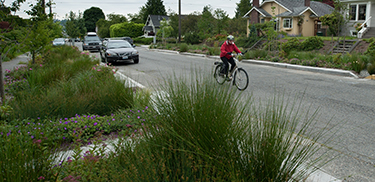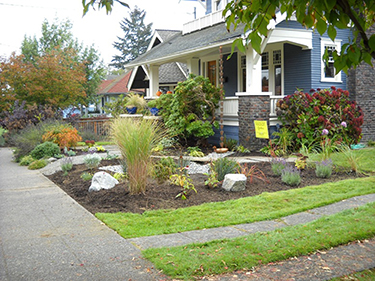|
Subscribe / Renew |
|
|
Contact Us |
|
| ► Subscribe to our Free Weekly Newsletter | |
| home | Welcome, sign in or click here to subscribe. | login |
Environment
| |
 |
February 27, 2014
Investing in green spaces can pay off for property owners
Natural Resources Defense Council

Davis
|
Nestled between Puget Sound and Lake Washington, Seattle’s unique beauty and quality of life are intimately tied to its local waterways.
Unfortunately, the water bodies that define the region are threatened by urban runoff, which flushes heavy metals, toxic chemicals, sediments — and sometimes raw sewage — into the city’s waterways when it rains.
However, adoption of greener approaches to stormwater management on commercial properties could help improve regional water quality while also generating significant value for private property owners.
Leading pollution source
Stormwater runoff is a common concern in cities and suburbs, where natural landscapes capable of infiltrating and filtering rainwater are transformed into impervious surfaces such as streets, rooftops and parking lots.
These hard surfaces prevent water from soaking into surrounding soil, producing large volumes of runoff that flow into local waterways untreated. In Seattle, polluted runoff is the leading source of pollution in urban rivers and creeks as well as the primary source of many contaminants in Puget Sound.
A new initiative
The impacts of urban runoff on local water quality have encouraged the city of Seattle and Seattle Public Utilities to develop innovative policies and programs aimed at reducing stormwater pollution.
One of the prominent solutions that Seattle has adopted is a commitment to rebuilding the city’s natural capacity to absorb rainwater through the use of green stormwater infrastructure. Green stormwater infrastructure (GSI) — such as urban trees, rain gardens and green roofs — help absorb, store and filter water, and are proven methods to help solve local stormwater runoff and pollution issues.
GSI projects, which have been increasingly adopted by municipalities across the U.S., can prove to be more cost-effective for cities than traditional “gray” stormwater systems (pipes and vaults), while also producing additional public benefits including increased open space, reductions in the urban heat-island effect, and cleaner air.
In 2013, Seattle continued its leadership in GSI implementation, when the City Council passed a resolution setting an ambitious goal to manage 700 million gallons of stormwater runoff annually using GSI by 2025. The city’s new GSI initiative brings together city departments, including the Office of Sustainability and Environment, Seattle Public Utilities, the Department of Transportation, Planning and Development, and Parks and Recreation to develop a coordinated approach to significantly increase the use of natural drainage systems on public lands.
Private investments
While restoring the “sponge” capacity of the city’s public property to absorb rainwater is essential, nearly two-thirds of Seattle’s land is private property. With so much land privately held, the active participation of these property owners is critical to helping the city meet its GSI development targets in a manner that is both financially efficient and timely.
Although the primary benefit produced by private property investments in GSI is the health and protection of public waters, a recent report by the Natural Resources Defense Council illustrates how investing in GSI can also produce a wide-range of financial benefits to private property owners.
A first-of-its-kind report, NRDC’s “The Green Edge: How Commercial Property Investment in Green Infrastructure Creates Value,” promotes a holistic benefits accounting methodology that considers all of the monetizable benefits that accrue to property owners who invest in GSI practices.
The report is available online at http://go.nrdc.org/greenedge.
Drawing on much of the recent academic and practitioner literature on the value created by urban green spaces, the Green Edge’s findings suggest that investing in natural landscapes produces more attractive properties that can draw higher rents (5-7 percent), increase customer retail spending and reduce crime. Additionally, these green assets can also result in energy savings, as trees provide shading and windbreak services, and green roofs can enhance insulation.
Finally, the Green Edge report notes that one of the key factors impacting the financial attractiveness of GSI projects is the incentives offered by the local municipality for the public services provided. As a result of the proven stormwater benefits produced by GSI, cities across the U.S. have begun to create incentives for private property owners to invest in green landscapes.
Seattle is no exception. The city’s Rainwise program helps subsidize the cost of GSI installation on private property, while the Stormwater Credit program provides permanent water bill rebates to those who install GSI practices on their property. Together these two programs are some of the more generous incentives in the nation — and send a strong signal to property owners that their active participation in GSI development is an important part of reducing the region’s stormwater pollution.
A healthier future
As Seattle grapples with how to accommodate additional development and population growth while also protecting Puget Sound, Lake Washington, Lake Union and other waterways that make Seattle unique, investments in natural solutions like GSI put us on a path toward a healthier and more attractive future.
Because watersheds are regional assets whose health depends on the collective action of all landowners, the engagement of both public and private property owners is essential to protecting local water quality. Fortunately, by applying the full-benefits accounting approach laid out in NRDC’s Green Edge report, an increasing number of property owners may find that investing in GSI not only helps make for a better Seattle, but is also a savvy financial decision.
Paul Davis is a sustainable finance fellow at the Natural Resources Defense Council.
Other Stories:
- No guts, more glory: Why it pays to go minimal
- LEED vs. Green Globes: How to choose
- How transparency can change the game on green building
- LEED shifts focus from design to performance
- LEED is here to stay so long as owners find it useful
- Old warehouse now a super-efficient office building
- U.S.-Mexico border crossing gets a net-zero makeover
- King County to try new rating system for infrastructure
- Historic rehab a test for performance-based codes
- Stone34 to put its deep green bona fides to the test
- State seeks to wring more value from its projects




